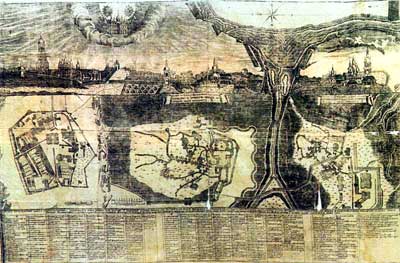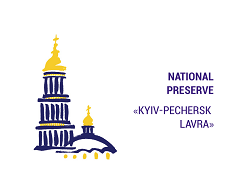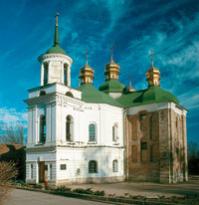XV – XVIII

Pechersk archimandrite Nykyfor Tur (1590-1599) was actively opposed to the political reformation of church; in his times, the monastery was under the Patriarch Constantinopolitan and got the stauropegion right approved.
After Nykyfor Tur’s death, in September 1599, the brethren appointed Yelisei Pletenetskyi, the Father Superior of the Pinskyi Lishynskyi monastery and a fervent advocate of Orthodoxy, Pechersk archimandrite. As Pechersk archimandrite for about 25 years, Yelisei Pletenetskyi contributed much to strengthening the authority of the monastery, expanding its territories, and improving the monastery livelihood and practices. During his office of an archimandrite, the Dormition Cathedral was refurbished, the hospital for the poor was repaired, and book printing was launched in Lavra.
In the struggle against the imposition of Catholicism and the Union, a significant role was played by Lavra typography founded in 1615. The typography brought together outstanding public and literary figures, scientists, and artists and engravers. Among them – Yelisei Pletenetskyi, Pamva Berynda, Zakhariia Kopystenskyi, Iov Boretskyi, Petro Mohyla, Afanasii Kalnofoiskyi, Inokentii Hizel, and many others. In luxury cases and decorated with engravings, the Lives of the Saints, Gospels, Akathisti, Psalters, ABC books, calendars, works on church history, including “Horologium” (1616), “Teraturhima” (1638) by Afanasii Kalnofoiskyi, “Ordinarium” (1645) by Petro Mohyla, “The Pecherskyi Paterikon” (1661), “Synopsis” (1674) by Inokentii Hizel, were released in Lavra typography. By the middle of XVIII century, Lavra typography had almost no competitors. Owing to works of such engravers as Illia, L. Tarasevych, D. Haliakhovskyi, A. Kozachkivskyi, and others, engraving achieved a high professional level and became a well-known genre of art. Publications of Kyiv-Pechersk typography were hugely popular not only because of the printing and artworks, but because of the refined visual style as well.
An important place in the history of the monastery holds archimandrite and then Kyiv Metropolitan Petro Mohyla. He was an active church figure, a farseeing and wise ruler. One of the main Petro Mohyla’s activities, aimed at strengthening the positions of Orthodox Church, was promotion of education. In 1631, Metropolitan Petro Mohyla founded a gymnasium in Kyiv-Pechersk Lavra, wherein along with theology, secular subjects were taught: grammar, rhetoric, geometry, arithmetic. In 1632, to train Orthodox clergy and secular elite in Ukraine, the gymnasium was merged with the Brethren School in Podil. The first higher institution in Ukraine, Kyiv Mohyla Collegium, was founded. Metropolitan Petro Mohyla also paid great attention to Pechersk typography activities.
In XVII century, with revitalization and strengthening the positions of Orthodox Church in Ukraine, the question of official canonisation of Pechersk Saints arose. In 1619, Kyiv-Pechersk monastery archimandrite Zakhariia Kopystenskyi, when editing the Festal Manaion (“The Anthologion”) for publishing it in Lavra typography, next to ecumenical and all-Rus Saints, put the names of 24 Pechersk monks who were locally venerated before. Hierarch Petro Mohyla, Lavra archimandrite and then Kyiv Metropolitan, started to apply for official Constantinople approval of Pechersk Saints canonisation. In 1643, in the City of Kyiv, “The Canon of the Pechersk Saints” was drawn up, that in the course of time gained the features of official church manifest that proclaimed veneration of Ukrainian Saints, and, first of all, the Pechersk ones. It counts 74 names; of those 41 were Lavra Saints (39 from the Near Caves and 2 from the Far Caves).
Only in 1762, the Russian Church proclaimed Pechersk Saints all-Russian ones. The formation of the modern Lavra Pantheon took a long time and was finally finished in the second half of XVIII century. The Pantheon of Saints consisted of 73 Venerables in the Near Caves and 45 Venerables in the Far Caves.
During the struggle of the Ukrainian people for national liberation in 1648-1654, Kyiv-Pechersk monastery was several times attacked and ruined. The Ukrainian higher Orthodox clergy had ambivalent feelings about joining Ukraine to Russia. The prospect to lose church, economic, and personal independence frightened Ukrainian hierarchs. It was more appropriate for higher Orthodox clergy, governed by Kyiv Metropolitan Sylvester Kosiv, to stay under the Patriarch Constantinopolitan’s jurisdiction than to transfer to the authority of Moscow Patriarch. That was one of the reasons why Ukrainian Orthodox hierarchs had objections to joining Ukraine to Russia. At first, Sylvester Kosiv and Pechersk archimandrite Yosyph Tryzna refused to bring the citizens of the City of Kyiv and monks to swear allegiance to Moscow tsar. And only under pressure of a part of the Cossacks who supported the Treaty of Pereiaslav, on January 19, 1654, Yosyph Tryzna had to hold the oath ceremony in the Dormition Cathedral.
After Yosyph Tryzna’s death in 1656, Lavra brethren appointed Inokentii Hizel, the foster-son of Petro Mohyla, their archimandrite. He governed the monastery in difficult times (1656-1684), when the monastery’s lands were desolated by Tatars and numerous fires destroyed a great part of manuscripts and Lavra publications.
In spring 1686, in the City of Moscow, the so-called Eternal Peace Treaty was signed and the Union against Turkey was established with Poland. The drastic consequence of this treaty was subordination of the Ukrainian Orthodox Church to Moscow Patriarchate which for several centuries deprived the Church of independence.
In the attempt to gain support of the Ukrainian clergy that opposed to abolition of its long-term rights and freedoms, the tsarist government started to issue grant-charters to the largest Ukrainian monasteries, and to Lavra, in particular, gave those funds, lands, and estates. Therefore, in the end of XVII-beginning of XVIII centuries, villeinage in Lavra reached the highest levels. By that time, the monastery owned 3 cities, 7 towns, 120 villages and farms with 56 thousand peasant serfs. The monastery’s ancestral lands counted several hundred industrial enterprises and trade institutions.
In XVII century, immense construction and repair and restoration works were conducted in Lavra. The architectural ensemble was enriched with stone churches: Saint Nikolas’ Church in Hospital monastery, the Church of St. Anne’s Conception, the Church of the Nativity of the Most Holy Theotokos, and the Church of Exaltation of the Holy Cross grew above the Caves. At that time, the stone Refectory House with the church was built. In hetman Ivan Mazepa’s means, around the upper territory of the Lavra, the fortified wall with four towers and three gates, and the All-Saints Church above the Economic Gate were built.
On the night between April 21-22, 1718, in the cell of Lavra satrap Barlaam Holenkovskyi a fire occurred, which destructed all wooden buildings and damaged stone constructions. A lot of church treasures and precious fabrics were destroyed; articles of precious metals and Lavra library were injured.
In 1720, immense reconstruction works started, which lasted for about half a century. At that time, a unique style, that got the name of the Ukrainian baroque, was being established in the Ukrainian art and in architecture, in particular. In this very style the Dormition Cathedral and the Trinity Church above the Gates were restored and fit up. In the thirties of XVIII century, the interiors of the Dormition Cathedral and the Trinity Church above the Gates were painted by best Lavra artists – Alimpii Halik, Ivan Maksymovych, Theoktist Pavlovslyi; the art works were carried out under guidance of craftsman Stephan Lubenskyi. The principles that formed the basis of the magnificent painting of these churches turned a pivotal sample for future church and monastery painting in Ukraine. Breath-taking architectural landmarks, highly artistic pieces of painting and applied arts were created by such eminent craftsmen as Stepan Kovnir, Nykyfor Horokh, construction engineer V. Novhorodtsev, masters I. Hryhorovych-Barskyi and Strembytskyi, architects F. Vasyliev, P. Neielov, Y. Shedel, and many others.
So, by the middle of XVIII century, in the picturesque amphitheatre of Dnipro hills, an architectural complex of Kyiv-Pechersk Lavra evolved, which survived until nowadays. During the build-up of the territory, the natural landscape was made a good use of: the upper table entails landscapes of the Upper Lavra, the Near Caves stretch on the hillside, and the southern hill welcomes the architectural ensemble of the Far Caves.









